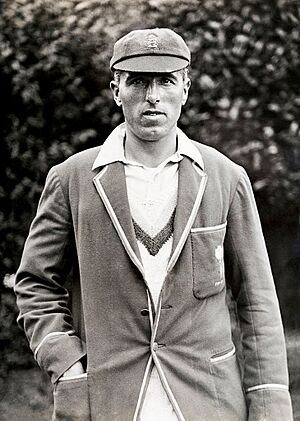George Geary facts for kids
 |
||||||||||||||||||||||||||||||||||||||||
| Personal information | ||||||||||||||||||||||||||||||||||||||||
|---|---|---|---|---|---|---|---|---|---|---|---|---|---|---|---|---|---|---|---|---|---|---|---|---|---|---|---|---|---|---|---|---|---|---|---|---|---|---|---|---|
| Born | 9 July 1893 Barwell, Leicestershire, England |
|||||||||||||||||||||||||||||||||||||||
| Died | 6 March 1981 (aged 87) Leicester, England |
|||||||||||||||||||||||||||||||||||||||
| Batting | Right-handed | |||||||||||||||||||||||||||||||||||||||
| Bowling | Right-arm fast-medium | |||||||||||||||||||||||||||||||||||||||
| International information | ||||||||||||||||||||||||||||||||||||||||
| National side | ||||||||||||||||||||||||||||||||||||||||
| Test debut | 10 July 1924 v South Africa | |||||||||||||||||||||||||||||||||||||||
| Last Test | 25 June 1934 v Australia | |||||||||||||||||||||||||||||||||||||||
| Career statistics | ||||||||||||||||||||||||||||||||||||||||
|
||||||||||||||||||||||||||||||||||||||||
|
Source: CricInfo, 2 March 2020
|
||||||||||||||||||||||||||||||||||||||||
George Geary (born 9 July 1893 – died 6 March 1981) was a famous English cricket player. He played for Leicestershire County Cricket Club and also for the England cricket team. George Geary was known for his amazing skills as a bowler, batsman, and fielder.
Contents
George Geary's Cricket Skills
George Geary was a right-handed bowler who threw the ball at a medium-fast speed. He was very good at making the new ball curve in the air. He also had a special way of changing his speed and spin without opponents noticing. This made him a tricky bowler to face.
He was known for being very determined. He could bowl many overs, even on pitches that were hard to play on. For example, in a Test match in Australia, he bowled 81 overs in very hot weather. His tall and strong body helped him bowl for a long time. It also helped him make the ball bounce high, which was useful in Australia.
Geary was also a good batsman, usually batting lower down the order. He often hit the ball hard, but he could also score runs steadily when his team really needed them. Even though he never scored 1,000 runs in a year, his runs were often very important. He was also an excellent fielder, especially at catching balls close to the batsman. He was almost always the best fielder on his team.
Starting His Cricket Journey
George Geary started playing for Leicestershire in 1912. By 1913, he became the main bowler for his team. In 1914, just before World War I, he took 114 wickets. This was a great achievement and showed how talented he was.
During World War I, Geary served in the air force. He had an accident where his leg was cut by an aeroplane propeller. This injury affected his strength for a while. In 1919, he didn't play as well, and in 1920, he didn't play any first-class games. He chose to play in a professional league instead.
However, he returned to Leicestershire in 1921. He quickly showed his skill again, taking 23 wickets on difficult pitches. In 1923, he became one of the best bowlers, taking 115 wickets. In 1924, he also improved his batting, scoring 864 runs. He made his first Test match appearance for England against South Africa that year.
Playing for England

In 1925, Geary continued to improve. He scored his first century (100 runs) in a match against Kent. In 1926, he had two amazing performances against strong teams. He took 14 wickets in matches against Hampshire and Lancashire. He played in two Test matches that year and helped England avoid defeat in one game.
In 1927, he played very well in South Africa, taking 12 wickets in one match. Many people thought he was the most dangerous bowler since the famous Sydney Barnes. However, a serious arm injury kept him out of the last three Test matches.
Even with his injury, Geary was chosen for the England team that toured Australia in 1928. This was because his strong build was perfect for the hard Australian pitches. He was very successful there, taking the most wickets for England. He worked incredibly hard to support England's very strong batting team.
The year 1929 was his best season ever. He took over 150 wickets. In one match, he took an amazing 10 wickets for only 18 runs. This was one of the best bowling performances in the history of first-class cricket at the time. He also scored his highest number of runs that year, with 923.
In 1930, when Australia toured England, Geary, like other English bowlers, found it hard to stop the legendary Don Bradman. Geary also had another injury. Because new bowlers like Bill Voce and Bill Bowes were getting better, Geary didn't keep his Test place in the next few years. He still bowled well in 1931 and 1932. In 1934, he was chosen for two more Test matches. He scored 53 runs in one game, which was a good effort against tough Australian bowlers. These were his last Test matches for England.
Later Years in Cricket
In 1935, Geary was in excellent form, especially on difficult pitches. He took 11 wickets for only 40 runs in a match against Sussex. In 1936, he had another amazing performance, taking 7 wickets for 7 runs and 13 wickets in total in one match.
In his last two seasons, 1937 and 1938, his bowling wasn't as strong. However, his batting in 1938 was the best it had ever been. He scored three centuries and averaged over 30 runs per innings.
Coaching and Legacy
George Geary retired from playing cricket at the end of 1938. But he didn't leave the sport. For over 20 years, he worked as a cricket coach at Charterhouse School. He was known as one of the best school coaches ever. A brilliant batsman named Peter May said that Geary's coaching was very important for his own development.
After leaving Charterhouse in 1959, Geary went to Rugby School. He helped them develop young players and improve their cricket team. He was always dedicated to his coaching. He even bowled in practice sessions without a sweater to keep cool until he was about 77 years old! This shows how incredibly strong and dedicated he was, even after many injuries. George Geary passed away in 1981 at the age of 87.

